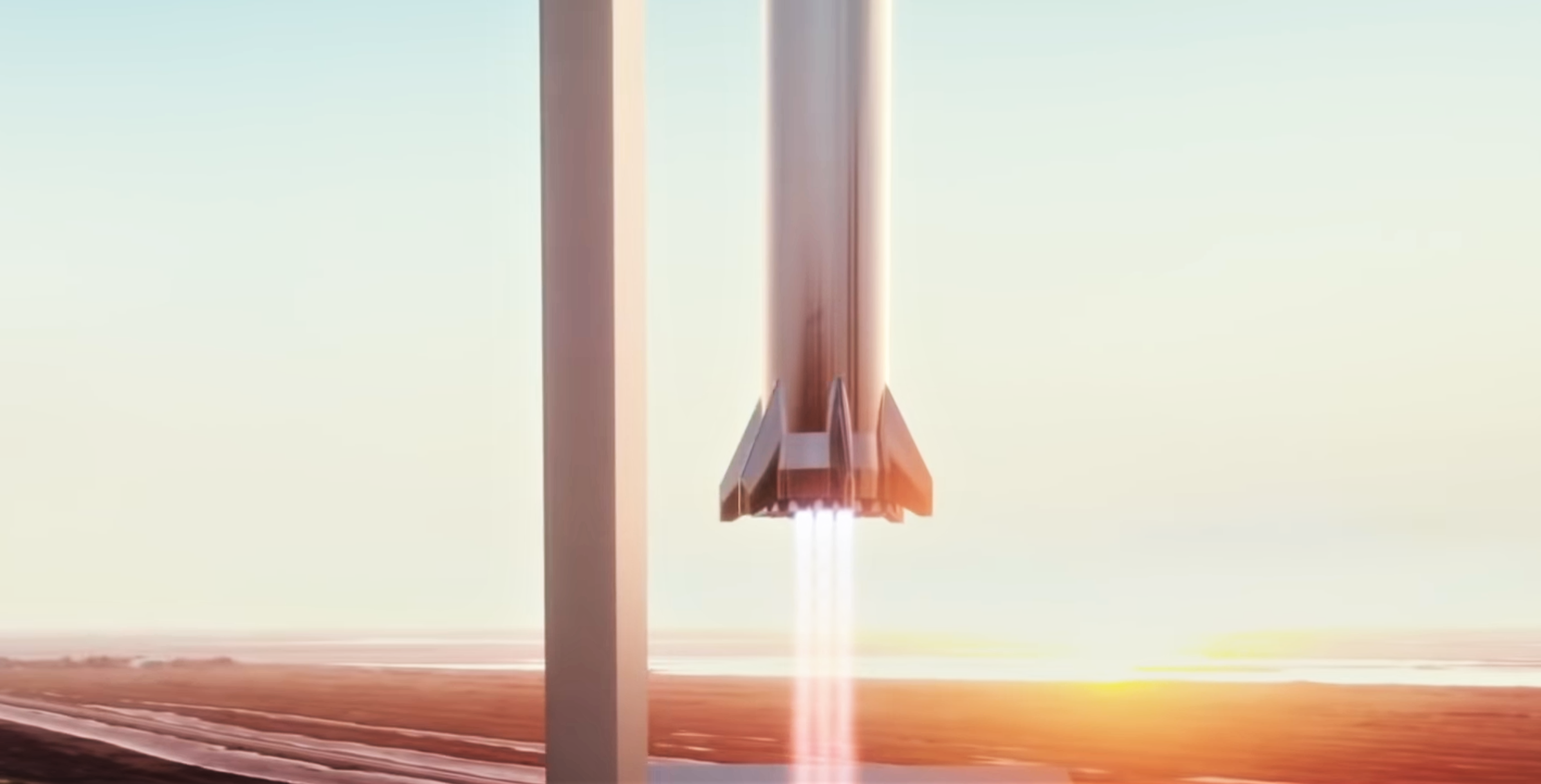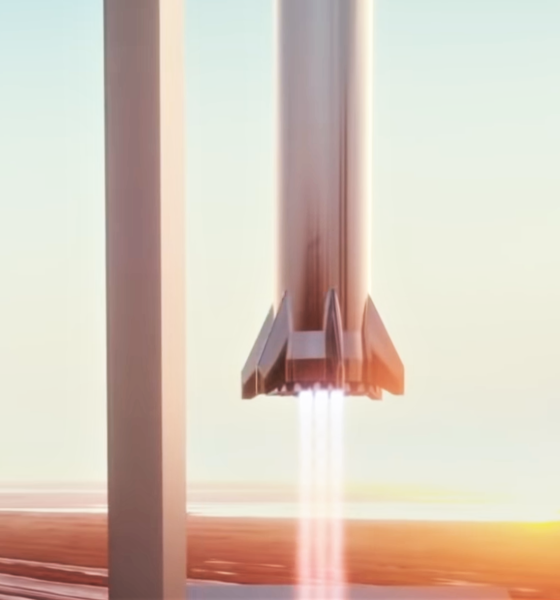

News
SpaceX might stack Starship on Super Heavy with “mechanical arms”
Not long after SpaceX CEO Elon Musk re-upped his plan to catch Super Heavy boosters – and possibly Starships, too – out of the air with a tower and giant arms, regulatory documents suggest that those arms might have even more uses.
A recent “aeronautical study” completed by the FAA ultimately concluded that SpaceX’s plans to build a 146-meter-tall (479′) Starship launch tower at its Boca Chica launch site would pose no hazards to aircraft, securing at least one of the many regulatory approvals SpaceX will need to proceed much further. Of note, whether the additional details are accurate or rather an error on behalf of the FAA employee managing the process, the FAA document notes that “the tower will be constructed out of structural steel trusses to allow the mechanical arms to lift vehicles.”
It’s unclear if “to lift vehicles” implies that whatever arm design SpaceX is pursuing includes some level of vertical mobility, effectively necessitating the creation of a custom elevator capable of lifting at least the weight of Starship (100-200 metric tons). On its own, designing, building, and qualifying mechanical arms that are simultaneously strong, gentle, and reliable enough to withstand the weight of several hundred-ton rockets carrying substantial momentum is an extreme challenge.
Making that extraordinarily complex recovery solution and the apparent structural reinforcements or major redesigns it would require for Starship and Super Heavy superior to something as simple and solved as landing legs is even more challenging, still. A step further, qualifying tower-with-arms recoveries and proving its reliability to the point that it’s safe for humans to rely on is even harder to imagine, still.
Most importantly, SpaceX will still unequivocally need to design, build, test, and fly Starship landing legs if it ever wants Starships to land anything on the Moon, Mars, or any planetary body – let alone NASA astronauts. SpaceX has already received $135 million in funding from NASA to complete its design for a Starship variant – with legs – that could be tasked with doing just that as few as four or five years from now. For SpaceX’s own Mars ambitions, a leg design capable of handling unprepared, uneven terrain is absolutely essential for Starship to ever reach the planet.
It remains to be seen if Musk’s recent aversion to landing legs – something already solved to an extent on SpaceX’s Falcon boosters – will bear any real fruit. As long as Starship still needs legs to land on other planets, which is the primary motivation behind the program’s entire existence, any rocket ‘catching’ efforts will have to be in addition to the development of reliable landing legs. Hinging all Starship and Super Heavy booster launches and (reusability-enabling) recoveries on an almost 500-foot-tall tower also risks becoming a glaring single point of failure that could delay all activity for months in the (demonstrably likely) event that the learning curve for an entirely unprecedented form of rocket recovery is a steep one.
For now, though, the tower continues to grow.

News
Tesla FSD fleet is nearing 7 billion total miles, including 2.5 billion city miles
As can be seen on Tesla’s official FSD webpage, vehicles equipped with the system have now navigated over 6.99 billion miles.

Tesla’s Full Self-Driving (Supervised) fleet is closing in on almost 7 billion total miles driven, as per data posted by the company on its official FSD webpage.
These figures hint at the massive scale of data fueling Tesla’s rapid FSD improvements, which have been quite notable as of late.
FSD mileage milestones
As can be seen on Tesla’s official FSD webpage, vehicles equipped with the system have now navigated over 6.99 billion miles. Tesla owner and avid FSD tester Whole Mars Catalog also shared a screenshot indicating that from the nearly 7 billion miles traveled by the FSD fleet, more than 2.5 billion miles were driven inside cities.
City miles are particularly valuable for complex urban scenarios like unprotected turns, pedestrian interactions, and traffic lights. This is also the difference-maker for FSD, as only complex solutions, such as Waymo’s self-driving taxis, operate similarly on inner-city streets. And even then, incidents such as the San Francisco blackouts have proven challenging for sensor-rich vehicles like Waymos.
Tesla’s data edge
Tesla has a number of advantages in the autonomous vehicle sector, one of which is the size of its fleet and the number of vehicles training FSD on real-world roads. Tesla’s nearly 7 billion FSD miles then allow the company to roll out updates that make its vehicles behave like they are being driven by experienced drivers, even if they are operating on their own.
So notable are Tesla’s improvements to FSD that NVIDIA Director of Robotics Jim Fan, after experiencing FSD v14, noted that the system is the first AI that passes what he described as a “Physical Turing Test.”
“Despite knowing exactly how robot learning works, I still find it magical watching the steering wheel turn by itself. First it feels surreal, next it becomes routine. Then, like the smartphone, taking it away actively hurts. This is how humanity gets rewired and glued to god-like technologies,” Fan wrote in a post on X.
News
Tesla starts showing how FSD will change lives in Europe
Local officials tested the system on narrow country roads and were impressed by FSD’s smooth, human-like driving, with some calling the service a game-changer for everyday life in areas that are far from urban centers.

Tesla has launched Europe’s first public shuttle service using Full Self-Driving (Supervised) in the rural Eifelkreis Bitburg-Prüm region of Germany, demonstrating how the technology can restore independence and mobility for people who struggle with limited transport options.
Local officials tested the system on narrow country roads and were impressed by FSD’s smooth, human-like driving, with some calling the service a game-changer for everyday life in areas that are far from urban centers.
Officials see real impact on rural residents
Arzfeld Mayor Johannes Kuhl and District Administrator Andreas Kruppert personally tested the Tesla shuttle service. This allowed them to see just how well FSD navigated winding lanes and rural roads confidently. Kruppert said, “Autonomous driving sounds like science fiction to many, but we simply see here that it works totally well in rural regions too.” Kuhl, for his part, also noted that FSD “feels like a very experienced driver.”
The pilot complements the area’s “Citizen Bus” program, which provides on-demand rides for elderly residents who can no longer drive themselves. Tesla Europe shared a video of a demonstration of the service, highlighting how FSD gives people their freedom back, even in places where public transport is not as prevalent.
What the Ministry for Economic Affairs and Transport says
Rhineland-Palatinate’s Minister Daniela Schmitt supported the project, praising the collaboration that made this “first of its kind in Europe” possible. As per the ministry, the rural rollout for the service shows FSD’s potential beyond major cities, and it delivers tangible benefits like grocery runs, doctor visits, and social connections for isolated residents.
“Reliable and flexible mobility is especially vital in rural areas. With the launch of a shuttle service using self-driving vehicles (FSD supervised) by Tesla in the Eifelkreis Bitburg-Prüm, an innovative pilot project is now getting underway that complements local community bus services. It is the first project of its kind in Europe.
“The result is a real gain for rural mobility: greater accessibility, more flexibility and tangible benefits for everyday life. A strong signal for innovation, cooperation and future-oriented mobility beyond urban centers,” the ministry wrote in a LinkedIn post.
News
Tesla China quietly posts Robotaxi-related job listing
Tesla China is currently seeking a Low Voltage Electrical Engineer to work on circuit board design for the company’s autonomous vehicles.

Tesla has posted a new job listing in Shanghai explicitly tied to its Robotaxi program, fueling speculation that the company is preparing to launch its dedicated autonomous ride-hailing service in China.
As noted in the listing, Tesla China is currently seeking a Low Voltage Electrical Engineer to work on circuit board design for the company’s autonomous vehicles.
Robotaxi-specific role
The listing, which was shared on social media platform X by industry watcher @tslaming, suggested that Tesla China is looking to fill the role urgently. The job listing itself specifically mentions that the person hired for the role will be working on the Low Voltage Hardware team, which would design the circuit boards that would serve as the nervous system of the Robotaxi.
Key tasks for the role, as indicated in the job listing, include collaboration with PCB layout, firmware, mechanical, program management, and validation teams, among other responsibilities. The role is based in Shanghai.
China Robotaxi launch
China represents a massive potential market for robotaxis, with its dense urban centers and supportive policies in select cities. Tesla has limited permission to roll out FSD in the country, though despite this, its vehicles have been hailed as among the best in the market when it comes to autonomous features. So far, at least, it appears that China supports Tesla’s FSD and Robotaxi rollout.
This was hinted at in November, when Tesla brought the Cybercab to the 8th China International Import Expo (CIIE) in Shanghai, marking the first time that the autonomous two-seater was brought to the Asia-Pacific region. The vehicle, despite not having a release date in China, received a significant amount of interest among the event’s attendees.








